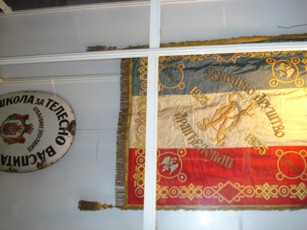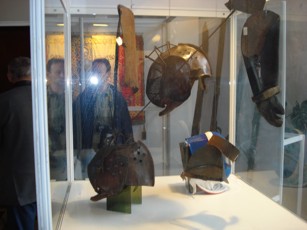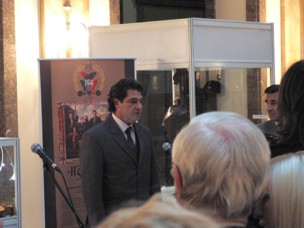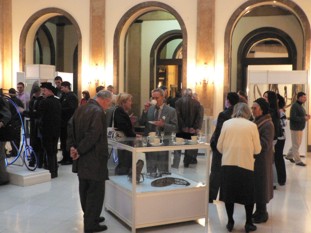Exercising & Sokol Movement
Speedy links
| © 2014 Факултет спорта и физичког васпитања, Универзитет у Београду | Благоја Паровића 156 | 11030 Београд, Србија | +381(11)3531-000 | контакт |
| The exhibition of 150 years of physical exercise and sports, and 125 years in Serbia sokolstva |
 |
 |
 |
| Museum of sport and Olympism | |||||||||
| Monday, 17 December 2007 00:00 | |||||||||
|
The exhibition of 150 years of physical exercise and sports, and 125 years in Serbia sokolstva was opened: Author of the exhibition: Marija Stojic When STEVA TODOROVIĆ painter came from Vienna to Belgrade 1857th, gathered around 16 pupils and Lyceum founded with the approval of authorities painting school, which taught them for free painting, taught singing, practiced in the fencing and organized them physical exercise (gymnastics). As an educated man knew the childrens needs for physical exercise, and even a high school student in Szeged loved the gymnastics and fencing, which he perfected while studying painting in Vienna and Munich, where he met the German training system. From the wars with Turkey (1876-1877) Principality of Serbia emerged victorious, after which the contract provisions of the Berlin became an independent state (1878). Many Serbian intellectuals were then returned to a free Serbia in order to transfer knowledge and experience gained in the developed European countries. One of them has made a significant contribution in the field of physical culture, and some of its parts. It was a time when physical education classes are introduced in primary and secondary schools, the idea first occurred on Civil gymnastics society, arrived sokolstva and knowledge of the sport. And just then 1881st , on the initiative of young Serbian physician Dr. Vladan Djordjevic, launched the idea of establishing a society for gymnastics, which was founded 1882nd under the name: Belgrade Society for gymnastics and fighting.' This acceptance sokolski Pan-Slavic ideology, which is reflected in the physical exercise to strengthen their own nations needs for national liberation and unification sveslovenskog all Slavic peoples, who have been occupied and were under someone elses rule, was met with resistance by certain Serbian circles, which are in a free and independent Kingdom of Serbia, asked for support in the rich cultural traditions and political history of his people. Thus they established track-Civil Society "Dušan Silni" 1892nd year, which later changed its name in knightly society "Dušan Silni". The modern sport came to Serbia in the late 19th century, and it accepted all categories of citizens, cherishing it first in private schools and civil society gymnastics, and later in a special sports clubs, who begin to be established in the late 19th century. Archery, fencing and horse competitions are a favorite traditional forms of competition in Serbia, as is always the better capability in these skills meant warriors ready, necessary in a turbulent political history of Serbia. The development of modern sport has encouraged the idea of restoring the ancient Olympic games, made it possible for it to appear, accepted and developed in a number of private schools, civil societies and sports gymnastics clubs of Serbia. An important incentive for accepting the Olympic idea in Serbia and complete knowledge of this great sporting event, had a five-day stay of King Aleksandar Obrenovic in Athens 1896th year during the first Olympic Games. In the late 19th and early 20th century, the Olympic idea was accepted in a number of sports clubs throughout Serbia. As a result of Belgrade was established in 1910th The Serbian oli mpijski Club, whose director was Captain Svetomir Djukic. Receive Serbian Olympic team and captain Svetomira Djukic the International Olympic Committee 1912th he was not only recognized for its achievements in the development of sport and the Olympic Movement in Serbia, but a strong impetus for its rapid and successful development. Between the two world wars sokolstva is seen to their full development, when the system entered the program contents of primary and secondary schools, as well as the army of the Kingdom of Yugoslavia, including all categories of people from children to adults, in the towns and villages. In the period after the Second World War, physical culture is organized on other grounds. It is primarily meant to ban Sokol of exercise, which took over the first gymnastic Board Yugoslavia 1948th years, until it formed the Alliance for physical education Partizan 1952nd year. 30 years STV Partizan gathered all categories of citizens who have to deal with the various forms of physical exercise and competition, representing the organized system of physical exercise for children and adults. In order to promote various sports and recreational facilities be made available to all categories of citizens 1992nd in Belgrade founded the Association of Sports for all. Over the past year organized a series of events such as Sport za sve, Svi na sneg, Dan izazova, Sokolski kamp, JU letnji festival rekreacije... In early nineties, after a gradual shutdown of activities and functions together creates an exothermic Partizan, there are ideas about restoring sokolstva in Serbia. So the Falcon Yugoslavia established 1992nd The City and the Union for sports and recreational facilities renamed the League of Falcon Belgrade. Falcon Serbia is founded in 1998. year, so the kite continued organization restored the former sokolstva traditions in modern conditions. In the past 150 years, from ten in the painting school practitioner Steve Todorovic (1857), the first kite in the last decade of the 19th century and the appearance of Serbian athletes at the Fifth Olympic Games in Stockholm (1912) Serbian athletes arrived to major international sporting success and winning numerous Olympic medals. Images from the exhibition
|
|||||||||
| Last Updated on Tuesday, 22 June 2010 07:26 |





















